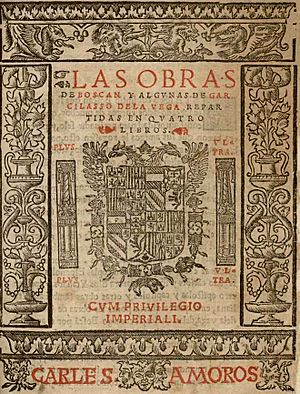Garcilaso de la Vega (poet) facts for kids
Quick facts for kids
Garcilaso de la Vega
|
|
|---|---|

Portrait at the New Gallery, Kassel
|
|
| Born | García Laso de la Vega 15 February 1498–1503 Toledo, Castile (present-day Spain) |
| Died | 14 October 1536 (aged 33–38) Nice, Duchy of Savoy (present-day France) |
Garcilaso de la Vega (born around 1501 – died October 14, 1536) was an important Spanish soldier and poet. He is famous for bringing new styles of poetry from the Italian Renaissance to Spain. Even though others tried, Garcilaso was the most successful in making these new forms popular. His poems were well-known during his lifetime and have remained popular ever since. His works were published after his death in 1543 by Juan Boscán.
Contents
Biography
Garcilaso was born in Toledo, Spain, sometime between 1498 and 1503. His father, also named Garcilaso de la Vega, was a nobleman and worked as an ambassador for the King and Queen of Spain. His mother was Sancha de Guzmán.
As the second son, Garcilaso did not inherit his father's main estate. However, he received an excellent education. He learned five languages: Spanish, Greek, Latin, Italian, and French. He also learned to play musical instruments like the zither, lute, and harp. When his father passed away in 1509, Garcilaso received a good amount of money.
After his schooling, Garcilaso joined the military. In 1520, he became an imperial guard for Emperor Charles V. He also became a member of the Order of Santiago in 1523, which was a special knightly order.
Garcilaso married Elena de Zúñiga in 1525. She was a lady-in-waiting for the King's sister, Leonor. They had several children together. Garcilaso also had an older son, Lorenzo, with Guiomar Carrillo.
Garcilaso's military career meant he traveled a lot and fought in many battles across Europe. He went to Italy, Germany, Tunisia, and France. In 1532, he was briefly sent away to an island on the Danube River. Later, in France, he fought his last battle. He died on October 14, 1536, in Nice, after being hurt in a fight at Le Muy. His body was later moved to the Church of San Pedro Martir in Toledo.
Works
Garcilaso de la Vega is best known for his sad and romantic poems. His poetry was different from earlier poets because it explored deeper feelings. His works show how his life changed over time.
He wrote many of his shorter, eight-syllable poems during his early "Spanish period." Later, during his "Italian period," he wrote mostly sonnets and songs. These were influenced by Italian poets like Petrarch. He used a new eleven-syllable line in Spanish, which allowed for more flexibility in his poems.
Garcilaso also helped introduce other types of stanzas to Spanish poetry. These include the estancia, which mixes eleven- and seven-syllable lines. He also used the "lira" and endecasílabos sueltos, which are unrhymed eleven-syllable lines.
Throughout his life, Garcilaso wrote many different poems. His works include:
- Forty Sonetos (Sonnets)
- Five Canciones (Songs)
- Eight Coplas (Couplets)
- Three Églogas (Eclogues)
- Two Elegías (Elegies)
- The Epístola a Boscán (Letter to Boscán)
His poems often mention old Greek and Roman myths. They also have a beautiful musical sound, with repeating sounds and rhythms. His poetry usually did not focus on religious themes. Many people say that Spanish poetry changed forever after Garcilaso de la Vega. His works have inspired many Spanish poets who came after him, including famous writers like Miguel de Cervantes and Lope de Vega.
Here is an example from his Égloga Tercera (Third Eclogue):
-
-
-
- Sometimes, a pure mind and a quiet voice
- are heard better,
- like honest witnesses of an innocent spirit,
- than the fancy words of a speaker.
-
-
He was very good at showing deep feelings in his writing, like in his "dolorido sentir" (painful feeling):
-
-
-
- They cannot take away my painful feeling,
- unless they first completely
- take away my senses.
-
-
Garcilaso's poetry also showed a new way of thinking about love, influenced by the Renaissance. This idea, called "neo-Platonism," saw love as a spiritual and ideal connection, different from traditional views. For example, in his Égloga primera (First Eclogue):
-
-
-
- Hand in hand with you,
- let's find other meadows and other rivers,
- other flowery and shady valleys,
- where I can rest, and always see you
- before my eyes,
- without fear or worry of losing you.
-
-
Garcilaso's influence continues even today. Modern poets like Seamus Heaney have found inspiration in his works.
Modern translations
- The Odes and Sonnets of Garcilaso de la Vega, translated by James Cleugh, (London: Aquila, 1930)
See also
 In Spanish: Garcilaso de la Vega para niños
In Spanish: Garcilaso de la Vega para niños


